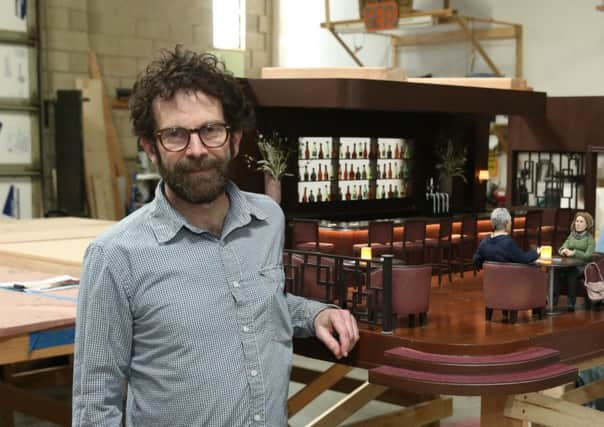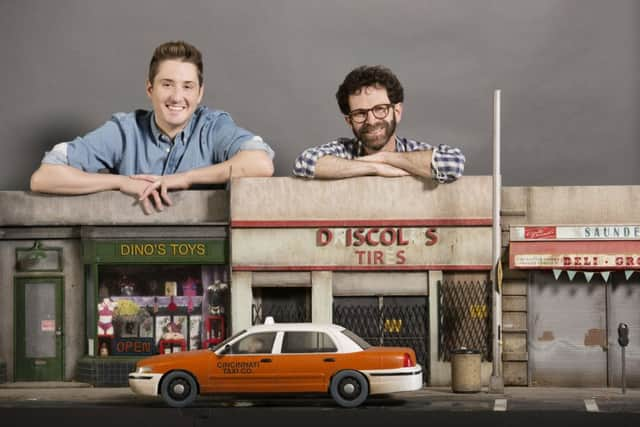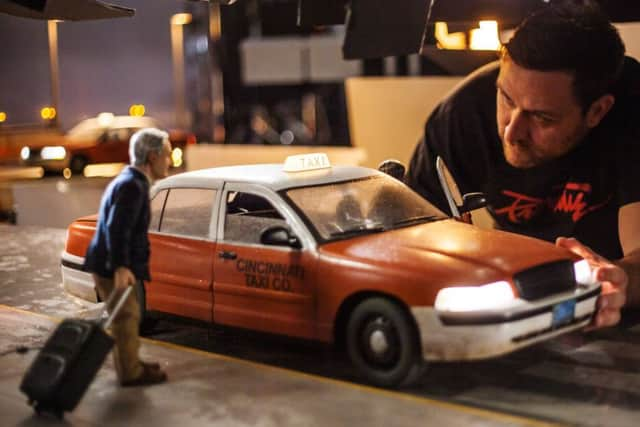Director Charlie Kaufman's name back in the frame with Anomalisa


When Charlie Kaufman first moved to Los Angeles in the early 1990s, the Boston University drama student turned New York University film school graduate became known in certain circles as the writer of the best sitcom pilot never made. It was called Depressed Roomies.
A few years later, following staff jobs on several failed sitcoms and a writing gig on The Dana Carvey Show (alongside the likes of Louis CK, Steve Carell and Stephen Colbert), Kaufman became known in slightly wider circles as the writer of the best movie script no one thought would ever get made. It was called Being John Malkovich.
Advertisement
Hide AdA few years after that – despite huge acclaim for Malkovich and Adaptation (both directed by Spike Jonze), an Academy Award for Eternal Sunshine of the Spotless Mind (shared with director Michel Gondry), and critical success for his directorial debut Synecdoche, New York – Kaufman became widely known as the genius writer who couldn’t get anything made. Full stop.


Not that he wasn’t trying. Frank or Francis, a satirical musical-comedy about Hollywood in the age of internet rage, was about to go into production in 2012 but fell apart at the last minute. This was despite a cast that included Carell, Jack Black, Eternal Sunshine star Kate Winslet, and Nicolas Cage, who memorably played Kaufman and his fictional brother Donald in the self-reflexive comedy Adaptation (which fictionalised Kaufman’s struggle to adapt Susan Orlean’s non-fiction book The Orchid Thief).
There were also a few television pilots, including one called How and Why, starring Michael Cera and Kaufman regular Catherine Keener. That one did get made, but the show wasn’t picked up.
It was as if Kaufman was becoming one of his own characters. Or in more Kaufman terms: it was as if the twisted reality he’d been projecting onto the big screen via his wracked-with-insecurity characters was now infecting his actual life. “It was a very difficult seven years for me,” says Kaufman when we meet in London’s Ham Yard Hotel.
“I was struggling to get stuff made and going in a lot of directions trying to get something done, so the idea that this was the thing that got finished and came out first is surprising to me.”


The “this” to which the 57-year-old filmmaker is referring is Anomalisa, a stop-motion film co-directed with animator Duke Johnson, and initially funded through Kickstarter (other investment came later on). It was Johnson – a 36-year-old graduate of cult television shows such as Moral Orel and Community – who was instrumental in convincing Kaufman to go down the crowd-funding route. And as dispiriting as that sounds, it reinforces just how difficult it has become to do anything original in an industry geared towards making everything the same.
Advertisement
Hide AdBut why did Kaufman suddenly find it so hard to get going again after being on such a roll?
The poor commercial performance of the aforementioned Synecdoche, New York seems to have played a part. Starring the late Philip Seymour Hoffman as a depressed theatre director who embarks on a solipsistic quest to find meaning in existence by mounting an epic play dramatising his own life, the 2008 film was an ambitious, brain-bending and very sincere attempt to grapple with big existential questions. It was also, arguably, a victim of its own artistic success. The layers of obfuscation Kaufman added to dramatise his character’s tail-chasing pursuit of unobtainable truths required a similarly obsessive level of commitment on the part of the viewer to unravel it all. Like the never-publically performed play at its centre, no one saw the film (it grossed just $3m at the US box-office off a reported $20m budget). Consequently, no one seemed to want to invest in Kaufman’s work.
Advertisement
Hide AdAnd yet movies were being made that were just strange enough around the edges to have the adjective “Kaufman-esque” applied to them – an irony that must have been frustrating as hell.


“One has to be careful about what one says so that one doesn’t come off as awful,” smiles Kaufman. “But since you brought it up, over the years, as I was struggling to get stuff made, yes, I found myself being used as an adjective to describe other things that other people were getting made. And the things that people were describing as ‘Kaufman-esque’ were things that I would never consider ‘Kaufman-esque’.
“So I’d read that and I’d have a lot of frustration and jealousy and maybe anger: How can this person, for whom I’m an adjective, make a movie and I can’t?”
Kaufman laughs. “So there, I said it, and now my career is over.”
Actually, nothing could be further from the truth. Anomalisa, which receives its official UK premiere at the closing night gala of this year’s Glasgow Film Festival, is currently in the running for an Oscar for best animated feature, alongside Pixar’s Inside Out, Studio Ghibli’s When Marnie Was There and Aardman’s Shaun the Sheep Movie. If the Academy wanted to finally acknowledge how much animation has grown up in recent years (a big if, but still…), honouring Anomalisa would be a good place to start.


It is, after all, a very adult-themed, very humane and, at times, very uncomfortable look at love and alienation, built around the story of a depressed motivational speaker called Michael Stone (voiced by David Thewlis) as he experiences a very dark night of the soul on a business trip to Cincinnati. Reeling from a stale marriage and a career that brings him no satisfaction, and haunted by his own history of abruptly ending relationships with no explanation, Michael looks for salvation in a one-night stand with a woman he’s convinced himself is different from everyone else in his life: a shy, facially scarred telesales operator named Lisa (Jennifer Jason Leigh).
Advertisement
Hide AdIf the plot sounds mundane, the film isn’t. Kaufman’s script once again explores neuroses rarely excavated with such candour – something enhanced by the use of stop-motion puppets and an intriguing conceptual quirk in which all the characters, bar Michael and Lisa, have the same face and the same voice (the latter is supplied by Tom Noonan, who played Hoffman’s fictionalised double in Synecdoche, New York).
As it happens, this conceit grew out of the film’s unusual origins. Back in 2005, the composer Carter Burwell – who scored Being John Malkovich and regularly works with the Coen brothers – asked Kaufman and the Coens to write plays for his Theatre of the New Ear series. “They were effectively staged radio plays, which we called ‘sound plays’,” says Kaufman. “The actors would have scripts on stage, there would be a Foley artist, and Carter would compose and conduct the music. We did it in New York, and we did it in London – at the Royal Festival Hall – and I wanted to go to LA with it, but the Coens couldn’t, so I had to write a second play to fill up the evening.”
Advertisement
Hide AdThe second play was Anomalisa (the first was called Hope Leaves the Theatre). In a nod to its biggest conceptual innovation, he wrote it under the pseudonym Francis Fregoli – a sly reference to the real psychological condition from which his protagonist is suffering (Fregoli is also the name of hotel in the movie). “I was thinking about how I could create a situation where one of the actors plays a lot of different people,” explains Kaufman of the original thinking behind the stage version of Anomalisa, which was done with somewhat limited resources and the same cast – Thewlis, Leigh and Noonan – that now features in the movie. “I’d read about this thing called the Fregoli Syndrome, which is a condition where you think everybody in the world is the same person and I thought that was an interesting metaphor for the story.”
It’s certainly useful for representing Michael’s disconnectedness from the world around him. It also ties in neatly with the scene in Being John Malkovich when that movie’s namesake enters the portal in his own head and encounters a world filled with people who look exactly like him, all uttering the word “Malkovich”.
“I’m not consciously thinking about those connections when I’m working,” says Kaufman, batting away the comparison. “Things appeal to me and then other people say, ‘Oh, it’s like this,’ and they’re right, but I’m not thinking about it.”
The connection between Being John Malkovich’s puppetry themes and the use of puppets as a storytelling device in the film version of Anomalisa, then, is also valid, but circumstantial.
“I didn’t go into this to make a stop-motion thing,” says Kaufman. “That’s something that they” – he points at Johnson, who has joined us – “wanted to do. But once we decided to do it, things that I’m interested in came into the conversation.”
The stop-motion angle came about after producer Dino Stamatopoulos, an old writing friend of Kaufman’s from The Dana Carvey Show days, asked if he could adapt the play into a movie for his new animation company, Starburn Industries. “We were tossing ideas back and forth and Dino said, I have this Charlie Kaufman script,” recalls Johnson (who’s also a partner at Starburn). “I thought, that sounds great. My first experience of it was reading the script and I thought it would work great as an animated film.”
Advertisement
Hide AdKaufman was more trepidatious. “By definition this was supposed to be non-visual and I liked the idea of that. There were things – specific things – that were ambiguous in the play. What’s physically wrong with Lisa, for instance: I never wanted that to be said so that people in the audience would imagine different things in their own separate little brains.”
Johnson roars with laughter at this last remark.
“Not ‘little brains’,” corrects Kaufman. “In their own separate brains; I have the utmost respect for my audience. But I was reticent because I knew that making everything concrete would lose some of that.”
Advertisement
Hide AdOne of the ways in which the film maintains a symbolic connection to the stripped-down live production is in the design of the puppets. They’re very life-like, but you can still see the joins – just as anyone who saw the play could see the machinations of the stage production.
“That’s interesting,” says Kaufman. “I hadn’t thought of that. I like that. What we were thinking about was that a lot of stop-motion uses this technique, but they paint out the seams in post-production. We wanted people to understand what they were looking at. That they were looking at a hand-animated thing and not something computer generated. We wanted people to understand the imperfections and frailties of the puppets and we were trying to use the form of stop-motion to further the themes and the metaphors that the story is talking about.”
It certainly enhances the already much-debated sex scene between Michael and Lisa. Kaufman says it was comical in the original stage version thanks to the disconnect that existed between what the audience was hearing and what it was seeing.
“David and Jennifer were standing 30 feet apart, moaning, so it was funny. That doesn’t exist in the movie.” Indeed it does not. This is not Team America. It may be one of the most intimate and detailed sex scenes in a commercially released film ever, but any discomfort comes from how human and real it feels, not because it features puppets.
“It was always our goal to figure out how not to make this a joke, how to make it an extension of their emotional experience,” says Kaufman. “We were very cognisant of the dangers of puppets having sex.”
The incremental nature of the production – only being able to watch a second or two of finished footage at a time over the course of three years – hardly lessened Kaufman’s anxiety about whether or not the film was going to work, but he’s pleased at the way it has turned out.
Advertisement
Hide Ad“I guess the proof is in the pudding, but if it does well in the world, it’s going to help me and Duke and everyone else involved.”
More than that, he’s happy about the way things seem to have got back on track. “We got this thing done, against all odds, with no help from any big entities and people are responding to it… It’s kind of a cool story, you know?”
• Anomalisa screens at Glasgow Film Festival tomorrow and goes on general release on 11 March, www.glasgowfilm.org/festival